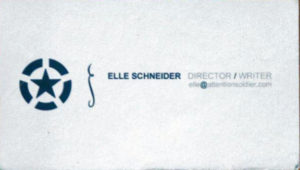Opposer Hachette claimed that the applied-for mark ELLE SCHNEIDER fails to function as a service mark for video production and script writing services. Applicant Lauren R. Schneider’s specimen of use is shown below. Hachette contended that applicant is using the name “Elle Schneider” as her personal name and/or pseudonym, and not as a service mark in connection with the advertisement, promotion or provision of the identified services. How do you think this came out? Hachette Filipacchi Presse v. Lauren R. Schneider, Opposition No. 91202984 (November 4, 2016) [not precedential].

The specimen business card depicts the term ELLE SCHNEIDER next to the wording “DIRECTOR/WRITER” and Applicant’s email address. Opposer Hachette maintained that the business card displays applicant’s name, Elle Schneider, but does not include any use of “Elle Schneider” as a service mark.
The Board observed that a personal name mark (not a surname) is deemed to be inherently distinctive “if the record shows that it is used in a manner that would be perceived by purchasers as identifying the services in addition to the person.” E.g., In re Carson, 197 USPQ 554 (TTAB 1977) (JOHNNY CARSON registrable as a service mark where name featured in advertisements for services).
The Board found the specimen here to be similar to that in Ex parte TOAL, 111 USPQ 450 (Comm’r Pat. 1956) wherein the applicant sought to register “Marguerite Charlene” as a service mark for script writing and song composition services. Her business card displayed “Marguerite Charlene,” “Scripts and Songs for Radio and Television Performances” and her street address. The Commissioner affirmed the refusal to accept the business card as a specimen because the alleged mark was used to identify an individual rendering a personal service and not a name adopted and used by applicant to identify and distinguish her services from those of others.
Here, applicant used “Elle Schneider” as an assumed name and she provided direction (of videos and film) and is a writer. “The depiction of her assumed name, along with ‘DIRECTOR/WRITER’ and her email address, on the business card also demonstrates the rendering of a personal service and not a name adopted and used by Applicant to identify and distinguish her services from those of others.”
The Board therefore found that Applicant’s specimen does not function as a mark for the services identified in Applicant’s application.
The Board also sustained Hachette’s likelihood of confusion claimed based on the registered mark ELLE for overlapping services. But the Board dismissed opposer’s dilution claim because, although applicant conceded that ELLE is famous in the fashion industry, that concession was not enough to establish that Applicant’s mark is a famous mark for purposes of Section 43(c)(1).

